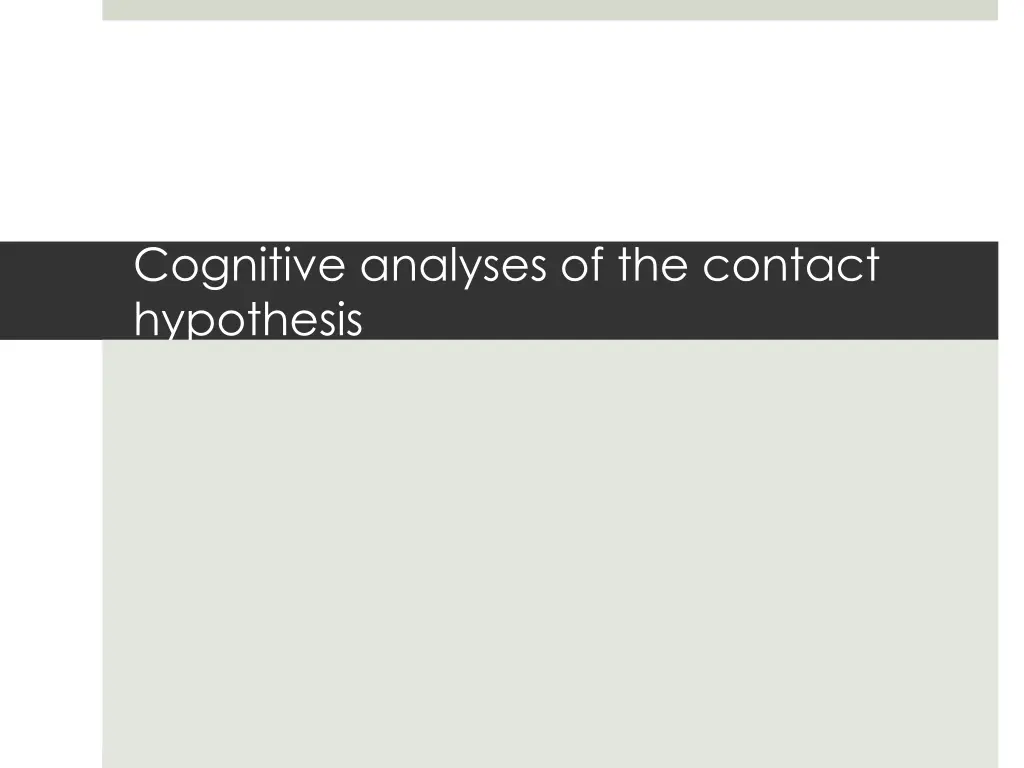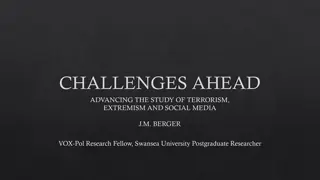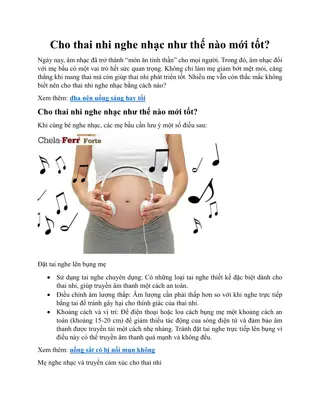
Cognitive Analyses of the Contact Hypothesis Explained
Explore the cognitive analyses of the contact hypothesis, focusing on intergroup perceptions, attitude change, and the cognitive perspective. Understand how intergroup relations and perceptions evolve, leading to attitude changes through contact. Dive into the traditional and cognitive approaches, examining the impact of stereotypes, intergroup contact, and more.
Download Presentation

Please find below an Image/Link to download the presentation.
The content on the website is provided AS IS for your information and personal use only. It may not be sold, licensed, or shared on other websites without obtaining consent from the author. If you encounter any issues during the download, it is possible that the publisher has removed the file from their server.
You are allowed to download the files provided on this website for personal or commercial use, subject to the condition that they are used lawfully. All files are the property of their respective owners.
The content on the website is provided AS IS for your information and personal use only. It may not be sold, licensed, or shared on other websites without obtaining consent from the author.
E N D
Presentation Transcript
Cognitive analyses of the contact hypothesis
The Cognitive Perspective The CH (i.e. contact hypothesis) outlines the condition under which the inter-group contact leads to attitude change The first limit of the CH deals with the lack of a theoretical model that may account for the effects on the CH on stability and change of intergroup perception
The Cognitive Perspective The Cognitive Perspective recasts the CH in the frame of the general cognitive process by which attributes of a category members modify (or not) category attributes The focus is the process (the why and how? ) The analyses is on the relationship between the attributes of a category member and the category attributes
The Cognitive Perspective The starting point of the Cognitive Perspective are the three assumptions of the traditional approach to inter- group relations.
The Cognitive Perspective The traditional approach characterizes inter-group relations and intergroup perceptions as a process of autistic hostility (Newcomb, 1947) That is, a self-amplifying cycle of antagonism, separation, and unrealistic negative attributions Inter-group hostility leads to avoidance which in turn leads both to more extreme negative perceptions and to an inability to test those perceptions against reality
The Cognitive Perspective The traditional approach claims that A) initial perception are unrealistic and potentially disconfirmable B) contact provides the evidence necessary to disconfirming these unrealistic beliefs C) the disconfirming attributes of the members generalize to the group as a whole.
The Cognitive Perspective The cognitive perspective claims that A) stereotypes beliefs different dramatically in their susceptibility to disconfirmation B) inter-group contact may either disconfirm or corroborate existing stereotypes, depending upon the nature of the intergroup contact
The Cognitive Perspective C) even when contact with disconfirming member occurs, cognitive process basic to underlying category- exemplar relations may isolate the exemplar from the group stereotypes.
The Cognitive Perspective As we said A) stereotypes beliefs different dramatically inter susceptibility to disconfirmation The susceptibility is a function of 1)Clarity of Concept-Exemplar 2) Criterion for trait Inferences 3) Contact setting
The Cognitive Perspective 1) The Clarity of Concept-Exemplar refers to degree with which a trait implies a behavioral referent Calm, compared to suspicious, has clearer referent behaviors (i.e. confirming and disconfirming behaviors) Traits denoting easily observable behaviors are expected to be amenable to disconfirmation, whereas traits for which is difficult to specify disconfirming behaviors may be more resistant to change.
The Cognitive Perspective 2) Criterion for trait Inferences Traits (that describe a group stereotype) differ in terms of the number of relevant observations required to establish or disconfirm those traits The more negative a trait, the less the number of instances required to confirm and the higher the number of instances to disconfirm (vice versa for positive traits) Positive traits are difficult to acquire but easy to lose Negative traits are easy to acquire but difficult to lose
The Cognitive Perspective 3) Contact setting Even when the clarity of the trait-behavior link are clear, the opportunities of observing that behavior are few think of heroic , the behavior might be clear but the occasions in which you might observe this behavior are low
The Cognitive Perspective As we said.. B) inter-group contact may either disconfirm or corroborate existing stereotypes, depending upon the nature of the intergroup contact Inter-group contacts may allow perceiver to come across confirming information Perceivers may preferentially encode stereotype- confirming rather disconfirming information (attentional filter)
The Cognitive Perspective As we said C) even when contact with disconfirming member occurs, cognitive process basic to underlying category-exemplar relations may isolate the exemplar from the group stereotypes. A general issue of the CH is whether the information disconfirming a group stereotype obtained trough contact generalizes to the category representation The generalization in question cannot taken from granted When does generalization occur?
The Cognitive Perspective To answer to this question, one should understand how group representations are build The cognitive perspective assumes that perceiver derives the attributes of a particular social category by retrieving those exemplars that are more strongly associated with the category
The Cognitive Perspective In other word Category attributes are base on retrieval of: exemplars that are more strongly associated with the category
The Cognitive Perspective Non social categories, such as objects, are build on defining attributes Such as a triangle has three angles, the some of the angles is equal to 180
The Cognitive Perspective Social category have not determined defining feature This means that the retrieval of the exemplars is not guided by this principle You should not formally defined a social group (what is an Italian?)
The Cognitive Perspective The attributes of a category are derived from the attributes of the exemplars that are more typical of the category Typicality refers to a degree of matching, area of resemblance between the exemplar and the prototype The prototype is the ideal exemplar that better exemplifies the category
The Cognitive Perspective Some exemplars are more typical than others Think of birds You might think of robins quickly and they look more representative than penguins.
The Cognitive Perspective Hence you might say that skin color is necessary to be categorize as African American, but this characteristic is not sufficient
The Cognitive Perspective African Americans are represented as athletic and aggressive Jack has a black skin but he is non athletic and non aggressive This makes Jack be atypical of African Americans
The Cognitive Perspective Since we derive a category representation from the typical exemplars that come to our mind Jack would not come to our mind (is not accessible) when think about African American
The Cognitive Perspective Concept representations are hierarchically structures Superordinate intermediate and subordinate category Birds robins - penguins
The Cognitive Perspective Information that does not fit the prototype is isolated in sub-category (subtyping) and/or associated with other categories (recategorization) Thus leaving the superordinate category intact
The Cognitive Perspective Said otherwise: the typicality determines the member- category matching The more a particular member disconfirms a stereotypic category of which he/she is an instance, the more likely it is to be associated with a different, possible alternative category or subtyped
The Cognitive Perspective John is a Black and is a scientist You will not think of John when think about Blacks as a whole You might isolate John in a subtype which is not activated when thinking of Blacks (subtyping) You might associated John with an alternative category, Scientists, thus not thinking of him when thinking of Blacks (recategorization)
The Cognitive Perspective Said otherwise: the typicality determines the member- category matching Disconfirming attributes can become associated with the stereotype of a group if these attributes belong to an individual who otherwise fits category stereotype
The Cognitive Perspective Paradox: To change one s stereotype, he/she should come across disconfirming instances
The Cognitive Perspective Paradox: To change one s stereotype, he/she should come across disconfirming instances The more the instances are perceived as atypical, the less they are retrieved when thinking of that group
The Cognitive Perspective Paradox: To change one s stereotype, he/she should come across disconfirming instances The more the instances are perceived as atypical, the less they are retrieved when thinking of that group Stereotypes are intact and disconfirming instances are isolated/associated with a different category
The Cognitive Perspective Paradox: To generalize from the instance to the group, we need typical exemplars But typical exemplars are not disconfirming instances, then do not prove stereotype revision
The Cognitive Perspective The current model predicts stability rather than change when dealing with disconfirming member
The Cognitive Perspective Testing the role of typicality in inferential processes.
The Cognitive Perspective The cognitive perspective assumes that inductive inferences, namely from individual member to the group as a whole, is a function of the typicality of the member
The Cognitive Perspective To test this assumption Rothbart (1996) presented participants a description of a sorority member Low typical Moderately typical Highly typical
The Cognitive Perspective Then, regardless the typicality of the member, participants were told the political preference of that member: Mondale vs. Regan
The Cognitive Perspective Dependent variable: Proportion of votes for Regan and Modale in the Sorority as a whole.
The Cognitive Perspective Dependent variable: Proportion of votes for Regan and Modale in the Sorority as a whole. Testing the inductive inference (generalization) as a function of the typicality of the individual member
The Cognitive Perspective Subjects learned about the category membership of 16 stimulus persons. Four of the men were Black Four of the men were Asian Four of the men were Gay Four of the men were fraternity members
The Cognitive Perspective Learning phase, to get who is who AFTER that, the strength of association between the category and the exemplar was tested How?
The Cognitive Perspective Participants were provided by a category name on a computer screen (e.g. ASIAN) for a brief duration, followed by one of the 16 names Participants press yes if the pairing was correct, and no if the pairing was incorrect
The Cognitive Perspective In sum, Inductive inferences are promoted by typical individual members, more so than by atypical individual members Category-member association is enhanced by typical member and inhibited by atypical member






















